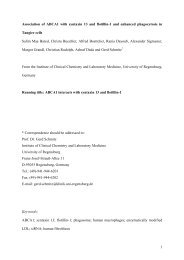SUNDAY, DECEMBER 4- Late Abstracts 1 - Molecular Biology of the ...
SUNDAY, DECEMBER 4- Late Abstracts 1 - Molecular Biology of the ...
SUNDAY, DECEMBER 4- Late Abstracts 1 - Molecular Biology of the ...
You also want an ePaper? Increase the reach of your titles
YUMPU automatically turns print PDFs into web optimized ePapers that Google loves.
<strong>SUNDAY</strong><br />
2047<br />
The Scar/WAVE complex is necessary for proper regulation <strong>of</strong> traction stresses during<br />
amoeboid motility.<br />
E. E. Bastounis 1 , R. Meili 2 , B. Alonso Latorre 2 , J-C. del Alamo 2 , J. Lasheras 2 , R. Firtel 2 ;<br />
1 Bioengineering, University <strong>of</strong> California, San Diego, San Diego, CA, 2 University <strong>of</strong> California,<br />
San Diego<br />
Chemotaxis, or directed cell migration, is involved in a broad spectrum <strong>of</strong> biological phenomena,<br />
ranging from <strong>the</strong> metastatic spreading <strong>of</strong> cancer to <strong>the</strong> active migration <strong>of</strong> neutrophils during<br />
wound healing or in response to bacterial infection. Chemotaxis requires a tightly regulated,<br />
spatiotemporal coordination <strong>of</strong> underlying biochemical processes. SCAR/WAVE-mediated<br />
dendritic F-actin polymerization at <strong>the</strong> cell’s leading edge plays a key role in cell migration. Our<br />
study identifies a mechanical and biochemical role for <strong>the</strong> SCAR/WAVE complex in modulating<br />
<strong>the</strong> traction stresses that drive cell movement. We demonstrate that <strong>the</strong> traction stresses <strong>of</strong><br />
wild-type Dictyostelium cells or cells lacking <strong>the</strong> SCAR/WAVE complex protein PIR121 (pirA-) or<br />
SCAR (scrA-) exert stresses <strong>of</strong> different strength that correlate with <strong>the</strong>ir levels <strong>of</strong> F-actin. By<br />
processing <strong>the</strong> time records <strong>of</strong> <strong>the</strong> cell length and <strong>the</strong> strain energy exerted by <strong>the</strong> cells on <strong>the</strong>ir<br />
substrate, we show that wild-type cells migrate by repeating a specific set <strong>of</strong> mechanical steps<br />
(motility cycle), whereby <strong>the</strong> cell length (L) and <strong>the</strong> strain energy exerted by <strong>the</strong> cells on <strong>the</strong>ir<br />
substrate (Us) vary periodically. Our analysis also revealed that scrA- cells exhibit an altered<br />
motility cycle with a longer period (T=160s) and a lower migration velocity (V =6μm/min)<br />
compared to those <strong>of</strong> wild-type cells (T=80s, V =13μm/min). In marked contrast to <strong>the</strong>se strains,<br />
pirA- cells, although <strong>the</strong>y have a higher F-actin content, migrate as slowly as scrA- cells but <strong>the</strong>ir<br />
migration occurs in a seemingly random manner in that <strong>the</strong>y lack <strong>the</strong> periodic changes in<br />
traction stresses that are observed for <strong>the</strong> o<strong>the</strong>r two strains. Finally, by quantifying <strong>the</strong> level <strong>of</strong><br />
F-actin in <strong>the</strong> leading edge in combination with <strong>the</strong> traction stresses, we demonstrated that <strong>the</strong><br />
level <strong>of</strong> leading edge, SCAR/WAVE complex-mediated F-actin polymerizations is critical for <strong>the</strong><br />
level and spatiotemporal control <strong>of</strong> <strong>the</strong> traction stresses, cell-substrate interactions, and <strong>the</strong><br />
motility cycle.<br />
2048<br />
Self-Generated EGF Gradients Guide Epi<strong>the</strong>lial Cell Migration.<br />
D. Irimia 1 , A. J. Aranyosi 1 , B. Kulemann 1 , S. Thayer 1 , M. Toner 1 , O. Illiopoulos 1 , C. Scherber 1 ;<br />
1 BioMEMS Resource Center, Massachusetts General Hospital/Harvard Medical School, Boston,<br />
MA<br />
Migrating epi<strong>the</strong>lial cells can contribute to wound healing processes, or can trigger lethal<br />
complications during cancer through invasion and distant metastasis. During <strong>the</strong>ir migration,<br />
cells must be able to orient accurately and it is generally assumed that gradients <strong>of</strong> chemokines<br />
or growth factors are required to guide epi<strong>the</strong>lial cells towards <strong>the</strong>ir target location.<br />
Unexpectedly, we uncovered a novel strategy for epi<strong>the</strong>lial cell orientation during migration that<br />
does not require pre-existent chemical gradients. Using microscale engineering techniques, we<br />
demonstrate that <strong>the</strong> strategy is dependent on <strong>the</strong> competition between epidermal growth factor<br />
(EGF) uptake by <strong>the</strong> cells and <strong>the</strong> restricted diffusion <strong>of</strong> EGF from surrounding<br />
microenvironment. Both normal and malignant epi<strong>the</strong>lial cells are capable <strong>of</strong> EGF uptake and<br />
can use this strategy when placed in confined environment. The strategy has some surprising<br />
consequences for epi<strong>the</strong>lial cells, like <strong>the</strong> ability to efficiently disperse through channels, or to<br />
navigate along <strong>the</strong> shortest path to exit from various microscopic mazes. Inhibition <strong>of</strong> EGFreceptor<br />
but not <strong>the</strong> inhibition <strong>of</strong> chemokine receptors, reduces <strong>the</strong> ability <strong>of</strong> <strong>the</strong> cells to orient,<br />
without altering <strong>the</strong>ir velocity <strong>of</strong> migration. Better understanding <strong>of</strong> <strong>the</strong> epi<strong>the</strong>lial cells guidance<br />
strategy by EGF uptake-dependent self-generated gradients could lead to approaches for
















